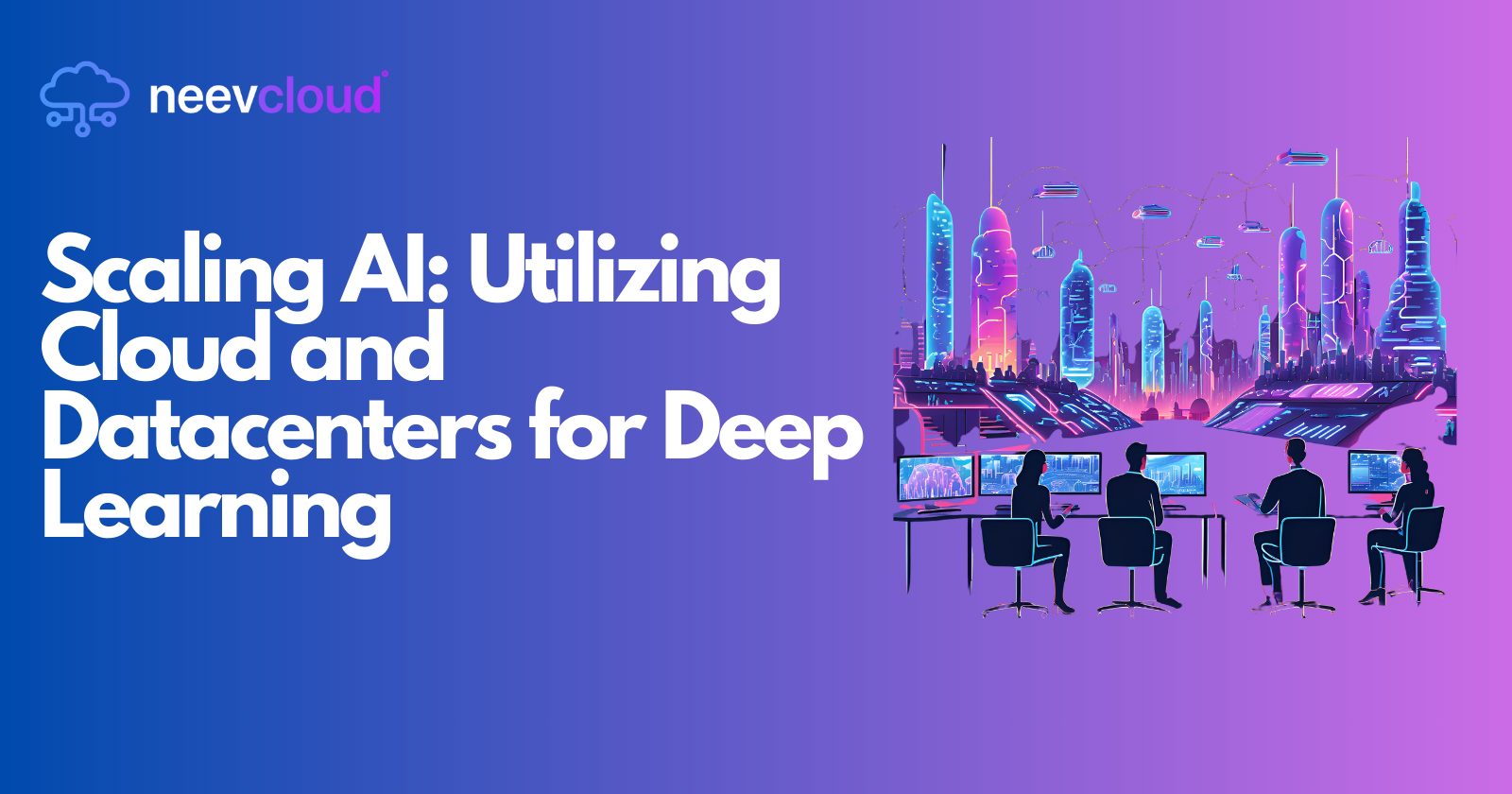Scaling AI: Utilizing Cloud and Datacenters for Deep Learning
 Tanvi Ausare
Tanvi Ausare
Introduction
Parallel and distributed deep learning represent critical advancements in modern AI. Leveraging AI cloud solutions and advanced AI datacenters, these methods enable unprecedented scalability, efficiency, and speed for deep learning workloads. With vast datasets and complex models becoming the norm, distributed systems offer a framework to train models faster, making deep learning accessible for various industries.
In this blog, we’ll delve into the fundamentals, approaches, and use cases of parallel and distributed deep learning in the AI cloud, with an emphasis on how AI datacenters are fueling this revolution.
Why Parallel and Distributed Deep Learning?
Scalability for Large Datasets: Massive datasets require distributed processing to break down tasks, optimize time, and achieve better results.
Enhanced Computational Power: Leveraging multiple GPUs or even entire datacenters allows for faster training cycles.
Real-Time Learning and Adaptation: Distributed learning enables rapid adjustments to model architectures or data without significant downtime.
Overcoming Hardware Limitations: With parallel processing, large models can bypass the memory constraints of a single GPU, enhancing resource allocation.
Optimized Workload Distribution: Efficiently distributing tasks ensures that complex models are processed effectively, lowering latency and energy consumption.
Key Concepts in Parallel and Distributed Deep Learning
Data Parallelism:
Splits data across multiple GPUs or nodes, where each one processes a portion of the data.
Useful for tasks where large datasets can be divided and worked on independently.
Involves aggregating results from each GPU or node after they complete their part.
Model Parallelism:
Splits a large model across several GPUs or machines.
Each segment of the model is handled by a different device, making it suitable for models too large for a single GPU.
Enables training on large models without hitting memory limits, but requires synchronization among components.
Pipeline Parallelism:
Divides both model and data across several stages of a “pipeline.”
Different stages can work simultaneously on various parts of the data or model.
Reduces idle times and boosts throughput, though inter-stage synchronization is crucial.
Hybrid Parallelism:
Combines data, model, and pipeline parallelism.
Often utilized in sophisticated AI datacenters and cloud-based AI solutions to achieve optimal training speeds.
Best suited for highly complex models where both data and model segmentation are necessary.
The Role of AI Cloud in Distributed Deep Learning
Elastic Scalability: AI clouds like NeevCloud provide flexible resource allocation, ensuring users can scale their resources in real-time according to workload demands.
High Availability of GPUs: With a dedicated AI cloud, there’s ready access to GPUs optimized for deep learning workloads.
On-Demand Infrastructure: Enterprises can deploy, train, and scale models on demand, cutting costs and reducing setup times compared to on-premises infrastructures.
Integration with Distributed Frameworks: NeevCloud supports leading frameworks such as TensorFlow, PyTorch, and Horovod, optimized for parallel processing.
AI Datacenters: Driving the Evolution of Distributed Deep Learning
AI datacenters are built to maximize deep learning throughput. Here’s how they optimize distributed learning:
Infrastructure for High-Speed Data Flow:
AI datacenters prioritize low-latency communication channels essential for synchronous distributed training.
High-speed networks like InfiniBand are commonplace, allowing for rapid data exchange between GPUs and nodes.
Energy-Efficient Hardware:
AI datacenters use energy-efficient hardware tailored for continuous GPU operations, thus minimizing energy costs for sustained deep learning training.
Cooling systems and custom layouts ensure GPUs and other hardware components remain at optimal performance levels.
Data Center-Specific GPUs:
AI-focused datacenters host advanced GPUs (e.g., NVIDIA A100, H100), designed for deep learning, featuring high memory and computing power.
Large memory capacity helps manage parallel and model-split workloads effectively.
Distributed Deep Learning Frameworks in AI Cloud and Datacenters
Horovod:
Developed by Uber, Horovod is a distributed training framework that scales across multiple GPUs with low overhead.
Utilizes the Message Passing Interface (MPI) to manage inter-GPU communication efficiently.
Ideal for AI datacenters where minimizing inter-device communication is crucial.
TensorFlow Distributed:
TensorFlow’s native support for distributed training allows for model and data parallelism across CPUs, GPUs, and TPUs.
Works seamlessly within AI cloud environments like NeevCloud, which provide the necessary infrastructure.
PyTorch Distributed:
PyTorch offers tools to distribute training across nodes with built-in support for mixed precision training and data/model parallelism.
Integrates well within AI cloud settings for real-time, scalable model training.
DeepSpeed:
DeepSpeed by Microsoft is focused on extreme scale deep learning, enabling models with billions of parameters.
With memory optimization techniques like ZeRO (Zero Redundancy Optimizer), DeepSpeed is suitable for the largest AI datacenters.
Distributed Data-Parallel (DDP):
Core component of PyTorch for synchronous distributed training.
Widely used in production settings where real-time model updates are essential.
Best Practices in Distributed Deep Learning in AI Clouds
Choosing the Right Parallelism Strategy:
- Analyze model and dataset size, available hardware, and latency requirements to select an optimal parallelism approach.
Optimizing Communication Overheads:
- AI clouds and datacenters typically deploy high-speed networks to reduce delays in data transfer and parameter aggregation.
Mixed Precision Training:
Using 16-bit floating point precision rather than 32-bit allows faster processing with minimal accuracy loss.
Essential for AI datacenters where multi-GPU setups can amplify computation speed without compromising model quality.
Distributed Deep Learning Use Cases Enabled by AI Cloud and Datacenters
Natural Language Processing (NLP):
Distributed learning allows large language models (LLMs) to train across multiple GPUs, reducing time significantly.
Enables real-time language understanding and generation applications on AI cloud.
Computer Vision:
From autonomous driving to medical imaging, distributed learning processes images across multiple nodes.
AI cloud infrastructure scales computer vision models for real-time applications, enhancing accuracy in visual recognition tasks.
Recommendation Systems:
Distributed learning supports the training of massive recommendation models by handling user interaction data at scale.
AI datacenters optimize recommendation models by running concurrent training across vast datasets.
Scientific Research and Simulation:
Climate modeling, genetic analysis, and physics simulations benefit from parallelized computations.
Distributed deep learning in AI datacenters allows researchers to process large datasets swiftly, accelerating scientific discovery.
Healthcare Applications:
From drug discovery to personalized medicine, distributed learning enables AI models to analyze complex biological datasets.
AI cloud solutions empower healthcare institutions to scale these models in a secure, HIPAA-compliant manner.
Challenges and Future Directions
Bandwidth and Latency:
Although AI clouds and datacenters provide low-latency networks, bandwidth-intensive applications still pose a challenge.
Future AI datacenters may leverage quantum networking and advanced fiber optics to mitigate these issues.
Fault Tolerance:
Distributed systems are prone to node failures; building resilience is critical to uninterrupted model training.
Upcoming AI cloud technologies will likely feature improved fault tolerance mechanisms.
Energy Consumption:
Distributed deep learning is resource-intensive; therefore, minimizing its energy footprint is a priority for sustainable AI.
Research in AI datacenters is focused on renewable energy sources and efficient resource allocation.
Model Parallelism for Extreme Scale Models:
Scaling to hundreds of billions of parameters requires innovative parallelism techniques.
Hybrid parallelism and model-sharding solutions are actively being developed to meet these demands.
Conclusion
Parallel and distributed deep learning within the AI cloud and AI datacenters marks a pivotal step in the evolution of artificial intelligence. Leveraging high-performance GPUs, low-latency networks, and advanced training frameworks, distributed learning is shaping next-generation AI applications. As cloud-based AI and data-centric models continue to scale, parallelism strategies will become integral to AI's future, empowering enterprises and researchers to unlock new levels of innovation. With solutions like NeevCloud, organizations can fully harness the power of distributed deep learning and drive transformative results across sectors.
Subscribe to my newsletter
Read articles from Tanvi Ausare directly inside your inbox. Subscribe to the newsletter, and don't miss out.
Written by
